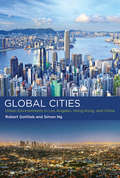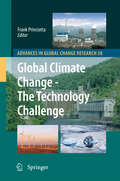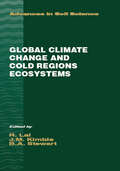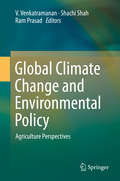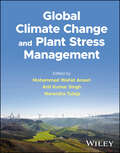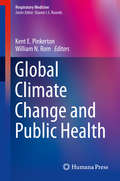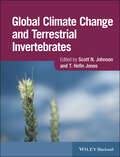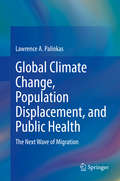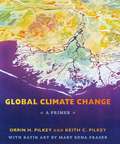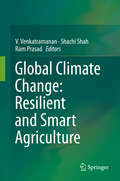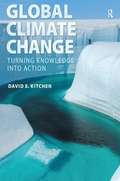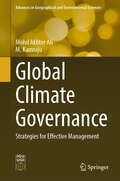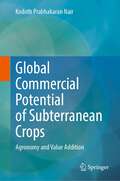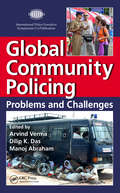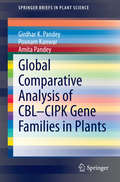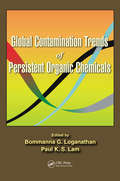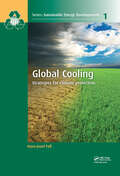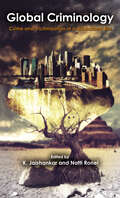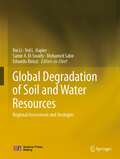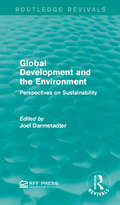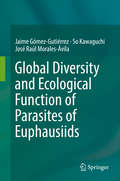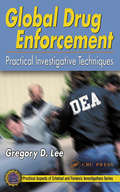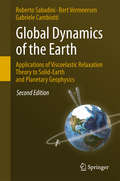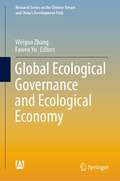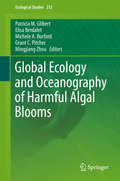- Table View
- List View
Global Cities: Urban Environments in Los Angeles, Hong Kong, and China (Urban and Industrial Environments)
by Robert Gottlieb Simon NgHow Los Angeles, Hong Kong, and China deal with such urban environmental issues as ports, goods movement, air pollution, water quality, transportation, and public space.Over the past four decades, Los Angeles, Hong Kong, and key urban regions of China have emerged as global cities—in financial, political, cultural, environmental, and demographic terms. In this book, Robert Gottlieb and Simon Ng trace the global emergence of these urban areas and compare their responses to a set of six urban environmental issues.These cities have different patterns of development: Los Angeles has been the quintessential horizontal city, the capital of sprawl; Hong Kong is dense and vertical; China's new megacities in the Pearl River Delta, created by an explosion in industrial development and a vast migration from rural to urban areas, combine the vertical and the horizontal. All three have experienced major environmental changes in a relatively short period of time. Gottlieb and Ng document how each has dealt with challenges posed by ports and the movement of goods, air pollution (Los Angeles, Hong Kong, and urban China are all notorious for their hazardous air quality), water supply (all three places are dependent on massive transfers of water) and water quality, the food system (from seed to table), transportation, and public and private space. Finally they discuss the possibility of change brought about by policy initiatives and social movements.
Global Climate Change - The Technology Challenge
by Frank PrinciottaIn order to avoid the potentially catastrophic impacts of global warming, the current 3% CO2 global emission growth rate must be transformed to a 1 to 3% declining rate, as soon as possible. This will require a rapid and radical transformation of the world's energy production and end use systems. The current generation of energy technologies are not capable of achieving the level of mitigation required. Next generations of renewable, low carbon generation and end use technologies will be needed. This book quantifies the mitigation challenge. It then considers the status of key technologies needed to protect the planet from serious climate change impact. Current and emerging technologies are characterized for their mitigation potential, status of development and potential environmental impacts. Power generation, mobile sources, industrial and building sectors are evaluated in detail. The importance and unique challenges for rapidly developing countries, such as China and India are discussed. Current global research and development efforts for key technologies are discussed. It is concluded that it will be necessary to substantially upgrade and accelerate the current worldwide RDD&D effort on both emerging energy technologies and those enabling technologies needed to improve mitigation effectiveness and economics. It will also be necessary to carefully evaluate the potential environmental characteristics of next generation technologies to avoid unacceptable health and ecological impacts. Finally, given the monumental technological challenge associated with transforming the world's energy system, geoengineering options are evaluated, since if successfully deployed, they have the potential to allow more time for the necessary energy system transformation. 'This book on Climate Change not only gives a clear picture of the problem but suggests many of the pitfalls in solving it and recommends strongly, a research program to fill the gaps in our knowledge. It is a most useful reference book for all aspects of the problem.' William D. Ruckelshaus, Madrona Venture Group/Evergreen Venture
Global Climate Change and Cold Regions Ecosystems
by B. A. Stewart R. Lal J. M. KimbleGlobal Climate Change and Cold Regions Ecosystems provides information on soil processes and the carbon cycle in cold ecoregions as well as the soil carbon pool and its fluxes in the soils of cold ecoregions. Filling a void in this area of soil science, this resource explains soil processes influencing C dynamics under natural and disturbed ecosyst
Global Climate Change and Environmental Policy: Agriculture Perspectives
by Ram Prasad Shachi Shah V. VenkatramananGlobal climate change threatens human existence through its potential impact on agriculture and the environment. Agriculture is climate-sensitive, and climate variability and climate change have net negative impact on it. Additionally, the agricultural landscape is affected by monoculture and agro-biodiversity loss, soil fertility depletion and soil loss, competition from biofuel production, crop yield plateaus and invasive species. Nevertheless, the global agricultural production system has to meet the food demands from the growing human population, which is set to exceed 10 billion by 2050. This book discusses the impacts of climate change on agriculture, animal husbandry and rural livelihoods. Further, since agriculture, forestry and other land-use sectors contribute about 10–12 gigatonnes of CO2-equivalent per year, it argues that agricultural policy must dovetail adaptation and mitigation strategies to reduce greenhouse gases emissions. This calls for a reformative and disruptive agricultural strategy like climate-smart agriculture, which can operate at all spatio-temporal scales with few modifications. The book also redefines sustainable agriculture through the lens of climate-smart agriculture in the context of the sustainability of Earth's life- support system and inter- and intra-generational equity. The climate-smart agriculture approach is gaining currency thanks to its inherent positive potential, and its goal to establish an agricultural system which includes "climate-smart food systems", "climate-proof farms", and "climate-smart soils". Climate-smart agriculture provides a pathway to achieve sustainable development goals which focus on poverty reduction, food security, and environmental health.
Global Climate Change and Plant Stress Management
by Narendra TutejaGlobal Climate Change and Plant Stress Management Understand the impact of climate change on plant growth with this timely introduction Climate change has had unprecedented consequences for plant metabolism and plant growth. In botany, adverse effects of this kind are called plant stress conditions; in recent years, the plant stress conditions generated by climate change have been the subject of considerable study. Plants have exhibited increased photosynthesis, increased water requirements, and more. There is an urgent need to understand and address these changes as we adapt to drastic changes in the global climate. Global Climate Change and Plant Stress Management presents a comprehensive guide to the effects of global climate change on plants and plant metabolism. It introduces and describes each climate change-related condition and its components, offering a detailed analysis of the resulting stress conditions, the environmental factors which ameliorate or exacerbate them, and possible solutions. The result is a thorough, rigorous introduction to this critical subject for the future of our biome. Readers will also find: Analysis of global climate change impact on various agricultural practices Socio-economic consequences of climate change and plant stress conditions, and possible solutions Strategies for sustainable agriculture Global Climate Change and Plant Stress Management is essential for researchers, scientists, and industry professionals working in the life sciences, as well as for advanced graduate students.
Global Climate Change and Public Health
by William N. Rom Kent E. PinkertonPulmonary physicians and scientists currently have minimal capacity to respond to climate change and its impacts on health. The extent to which climate change influences the prevalence and incidence of respiratory morbidity remains largely undefined. However, evidence is increasing that climate change does drive respiratory disease onset and exacerbation as a result of increased ambient and indoor air pollution, desertification, heat stress, wildfires, and the geographic and temporal spread of pollens, molds and infectious agents. Preliminary research has revealed climate change to have potentially direct and indirect adverse impacts on respiratory health. Published studies have linked climate change to increases in respiratory disease, including the following: changing pollen releases impacting asthma and allergic rhinitis, heat waves causing critical care-related diseases, climate driven air pollution increases, exacerbating asthma and COPD, desertification increasing particulate matter (PM) exposures, and climate related changes in food and water security impacting infectious respiratory disease through malnutrition (pneumonia, upper respiratory infections). High level ozone and ozone exposure has been linked to idiopathic pulmonary fibrosis, lung cancer, and acute lower respiratory infection. Global Climate Change and Public Health is an important new volume based on the research, findings, and discussions of US and international experts on respiratory health and climate change. This volume addresses issues of major importance to respiratory health and fills a major gap in the current literature. The ATS Climate Change and Respiratory Health Workshop was held in New Orleans, Louisiana, on May 15, 2010. The purpose of the meeting was to address the threat to global respiratory health posed by climate change. The workshop was attended by domestic and international experts as well as representatives of international respiratory societies and key US federal agencies. Dr. Pinkerton and Dr. Rom, the editors of this title, were co-chairs of the Climate Change Workshop and Symposium.
Global Climate Change and Terrestrial Invertebrates
by Scott N. Johnson T. Hefin JonesInvertebrates perform such vital roles in global ecosystems—and so strongly influence human wellbeing—that biologist E.O. Wilson was prompted to describe them as “little things that run the world.” As they are such powerful shapers of the world around us, their response to global climate change is also pivotal in meeting myriad challenges looming on the horizon—everything from food security and biodiversity to human disease control. This book presents a comprehensive overview of the latest scientific knowledge and contemporary theory relating to global climate change and terrestrial invertebrates. Featuring contributions from top international experts, this book explores how changes to invertebrate populations will affect human decision making processes across a number of crucial issues, including agriculture, disease control, conservation planning, and resource allocation. Topics covered include methodologies and approaches to predict invertebrate responses, outcomes for disease vectors and ecosystem service providers, underlying mechanisms for community level responses to global climate change, evolutionary consequences and likely effects on interactions among organisms, and many more. Timely and thought-provoking, Global Climate Change and Terrestrial Invertebrates offers illuminating insights into the profound influence the simplest of organisms may have on the very future of our fragile world.
Global Climate Change, Population Displacement, and Public Health: The Next Wave of Migration
by Lawrence A. PalinkasThis timely text examines the causes and consequences of population displacement related to climate change in the recent past, the present, and the near future. First and foremost, this book includes an examination of patterns of population displacement that have occurred or are currently underway. Second, the book introduces a three-tier framework for both understanding and responding to the public health impacts of climate-related population displacement. It illustrates the interrelations between impacts on the larger physical and social environment that precipitates and results from population displacement and the social and health impacts of climate-related migration. Third, the book contains first-hand accounts of climate-related population displacement and its consequences, in addition to reviews of demographic data and reviews of existing literature on the subject. Topics explored among the chapters include: Hurricane Katrina and New Orleans Hurricane Maria and Puerto Rico The California Wildfires Fleeing Drought: The Great Migration to Europe Fleeing Flooding: Asia and the Pacific Fleeing Coastal Erosion: Kivalina and Isle de Jean Charles Although the book is largely written from the perspective of a researcher, it reflects the perspectives of practitioners and policymakers on the need for developing policies, programs, and interventions to address the growing numbers of individuals, families, and communities that have been displaced as a result of short- and long-term environmental disasters. Global Climate Change, Population Displacement, and Public Health is a vital resource for an international audience of researchers, practitioners, and policymakers representing a variety of disciplines, including public health, public policy, social work, urban development, climate and environmental science, engineering, and medicine.
Global Climate Change: A Primer
by Orrin H. Pilkey Keith C. PilkeyAn internationally recognized expert on the geology of barrier islands, Orrin H. Pilkey is one of the rare academics who engages in public advocacy about science-related issues. He has written dozens of books and articles explaining coastal processes to lay readers, and he is a frequent and outspoken interviewee in the mainstream media. Here, the colorful scientist takes on climate change deniers in an outstanding and much-needed primer on the science of global change and its effects. After explaining the greenhouse effect, Pilkey, writing with son Keith, turns to the damage it is causing: sea level rise, ocean acidification, glacier and sea ice melting, changing habitats, desertification, and the threats to animals, humans, coral reefs, marshes, and mangroves. These explanations are accompanied by Mary Edna Fraser's stunning batiks depicting the large-scale arenas in which climate change plays out. The Pilkeys directly confront and rebut arguments typically advanced by global change deniers. Particularly valuable are their discussions of "Climategate," a manufactured scandal that undermined respect for the scientific community, and the denial campaigns by the fossil fuel industry, which they compare to the tactics used by the tobacco companies a generation ago to obfuscate findings on the harm caused by cigarettes.
Global Climate Change: Resilient and Smart Agriculture
by Ram Prasad Shachi Shah V. VenkatramananThis book provides essential insights into methods and practices of ‘Climate-smart Agriculture,’ which is driven by the principles of climate resilience and smart resource use in agricultural production. Climate-smart agriculture is a key policy instrument for achieving poverty eradication and a hunger-free world, as well as mitigating the effects of climate change. This book discusses in detail climate-smart agricultural technologies and practices that can reduce the vulnerability of agricultural systems, improve the livelihoods of farmers and other stakeholders, and reduce the greenhouse gas emissions from crop production and livestock husbandry. The agriculture, forestry and other land use (AFOLU) sector produces roughly 10–12 gigatons of CO2-equivalent per year; therefore, sustainable practices for agriculture and related land use hold immense potential to mitigate climate change. The potential impacts of climate variability and climate change on agriculture are extensively documented and articulated, especially with regard to global and national environmental agendas that call for innovation, transformation and climate-resilient advances in agriculture. As the book demonstrates, climate-smart agriculture offers an excellent tool for boosting agricultural output to feed the growing global population; for reducing greenhouse gases emissions from agriculture and other land use; and for protecting agricultural production systems from the impending dangers of climate change.
Global Climate Change: Turning Knowledge Into Action
by David KitchenThis book examines what scientists know about global warming and climate change and considers political and economic solutions that will balance the competing needs of people around the world.
Global Climate Governance: Strategies for Effective Management (Advances in Geographical and Environmental Sciences)
by Mohd Akhter Ali M. KamrajuThis book serves as a comprehensive and insightful guide to the strategies and mechanisms that underpin effective climate governance on a global scale. From the Paris Agreement to the ongoing efforts within the United Nations Framework Convention on Climate Change (UNFCCC), this book offers an in-depth examination of the international and national initiatives that have emerged to address the intricate and multifaceted problem of climate change. It also provides an exploration of the scientific, political, and economic forces shaping the global climate landscape, casting a discerning light on the evolving dimensions of climate governance. The key features of the book are: 1) Understanding the Science: The book lays the foundation for a comprehensive understanding of the scientific principles underpinning climate change. 2) Political Dynamics: It delves into the intricacies of international climate negotiations, the roles played by major stakeholders, and the historical development of seminal climate agreements. 3) National Policies: The book goes beyond the international arena to investigate the diverse approaches and strategies adopted by nations worldwide. It explores their efforts to mitigate emissions, adapt to changing climate conditions, and promote sustainability at the national level. 4) Case Studies: Real-world case studies drawn from various regions and industries illuminate the successes and challenges of climate governance. These case studies offer valuable lessons for readers seeking practical insights into climate change solutions. 5) Innovations and Solutions: The book showcases the innovative technologies and strategies being developed to combat climate change. 6) Balanced Perspective: The book embraces a balanced perspective that confronts the complexities of climate governance, while also offering a beacon of hope by presenting actionable solutions for a sustainable, resilient future.
Global Commercial Potential of Subterranean Crops: Agronomy and Value Addition
by Kodoth Prabhakaran NairTropical root and tuber crops form an important group of food crops for millions of people (about one-fifth of the world population), especially those living in the tropical and sub-tropical zones. Tuber crops are the third important food crops after cereals and grain legumes. The carbohydrates synthesized in the leaves and stored in the form of starch in the underground roots and tubers, which are not only for food, but also a raw material for several industries. Among the many tuber crops available, only a few have been domesticated and widely cultivated for edible and industrial purposes. This book addresses the principal issues connected with selected tuber and root crops, their origin, global distribution, cultivation details, and their global commercial potential, vis-à-vis the end products made out of them (value addition). Among the crops, sweet potato, cassava, yams, colocasia, west Indian arrowroot, asparagus, safed musli, Indian Bread root and gloria superba will be discussed.From various projections, it is evident that by the year 2050 the world population will face a serious food shortage, if current trends in cereals consumption is taken intoaccount. That is why root and tuber crops assume great importance. Contrary to the high-fertility soils, which are a requirement for principal cereals like rice and wheat, root and tuber crops can grow quite well in poor soils, under varying climatic conditions.
Global Community Policing: Problems and Challenges
by Arvind Verma, Dilip K. Das and Manoj AbrahamIn nations all over the world, community policing has been found extremely beneficial in improving public confidence in the police. Community-oriented policing and police-citizen cooperation is now the accepted framework for all progressive police departments. Drawn from the proceedings at the 2010 International Police Executive Symposium (IPES) in
Global Comparative Analysis of CBL-CIPK Gene Families in Plants
by Amita Pandey Girdhar K. Pandey Poonam KanwarCalcium plays pivotal role in regulating the physiological as well as developmental processes in plants. Till now, several calcium sensors have been discovered, which regulate the diverse signaling pathways involved in plant growth and development. One of the major calcium sensors CBL (calcineurin B-like) is decoding the calcium signal during various environmental stresses in plants. Calcium mediated signal is transduced downstream by CBL-interacting protein kinases (CIPKs), which generally phosphorylate the target proteins such as transcription factors or transporters/channel leading to a response. Mutant based approach has provided valuable information in the functional analysis of individual members of CBL and CIPK gene family in Arabidopsis. Both CBL and CIPK gene families have previously been identified and characterized in Arabidopsis and rice. Identification and characterization of CBLs and CIPKs in other plant species such as Oryza sativa, Pisum sativum, Cicer arietinum, Zea mays, Populus euphratica, Vitis vinifera, Malus domestica, Gossypium hirsutum, Sorghum bicolor, Brassica napus, Vicia faba, Phaseolus vulgaris, Ammopiptanthus mongolicus and Triticum aestivum are still in juvenile stage. Overall, Global Comparative Analysis of CBL-CIPK Gene Families in Plants is a comprehensive study focused on the diverse role of CBL-CIPK module in different stress signaling and also to identify a newly emerging role of this calcium-signaling module in plant growth and development across different plant species. In addition, beside Arabidopsis, it will provide backbone of knowledge to perform a detail molecular investigation in crop plant species and could possibly enable in designing strategies to tame abiotic stress tolerance and development in important agronomical crop plants. This book will act as handy and informative source in this field for students as well as advanced researchers.
Global Contamination Trends of Persistent Organic Chemicals
by Bommanna G. Loganathan Paul K. S. LamEnvironmental pollution by man-made persistent organic chemicals (POCs) has been a serious global issue for over half a century. POCs are prevalent in air, water, soil, and organisms including wildlife and humans throughout the world. They do not degrade and cause long-term effect in organisms. Exposure to certain POCs may result in serious environ
Global Cooling: Strategies for Climate Protection (Sustainable Energy Developments)
by Hans-Josef FellThis book redefines climate protection measures and readjusts climate protection targets in line with what is scientifically necessary and economically feasible. The reader is provided with an overview of recent developments and failings in, and successful instruments for, fighting climate change and global warming.Effective climate protection meas
Global Criminology: Crime and Victimization in a Globalized Era
by K. Jaishankar Natti RonelGlobal criminology is an emerging field covering international and transnational crimes that have not traditionally been the focus of mainstream criminology or criminal justice. Global Criminology: Crime and Victimization in a Globalized Era is a collection of rigorously peer-reviewed papers presented at the First International Conference of the So
Global Degradation of Soil and Water Resources: Regional Assessment and Strategies
by Rui Li Ted L. Napier Samir A. El-Swaify Mohamed Sabir Eduardo RienziThis book focuses on soil and water conservation at global scale. It is a serious environmental problem that will threaten the socio-economic well-being of the majority of global population in future. The book examines the current situation of land degradation in multiple regions of the world and offers alternative approaches to solve the problems through sharing advanced technologies and lessons learned. It provides comprehensive assessment on characteristics, level and effect of degradation in different regions. It’s a highly informative reference both for researchers and graduate students.
Global Development and the Environment: Perspectives on Sustainability (Routledge Revivals)
by Joel DarmstadterIn preparation for the United Nation’s Conference on Environment and Development in Rio de Janeiro in June 1992, this study aimed to detail enduring environmental issues that might or might not have been considered at the conference. Originally published earlier that year, Global Development and the Environment questions the compatibility of goals for environmental protection, natural resource consequences and economic growth in relation to sustainability with essays on important topics such as biodiversity, agriculture and population issues. This title will be of interest to students of Environmental Studies and Economics.
Global Diversity and Ecological Function of Parasites of Euphausiids
by Jaime Gómez-Gutiérrez So Kawaguchi José Raúl Morales-ÁvilaThis volume critically reviews all previously published work of parasites that interact with krill (order Euphausiacea) updating misconceptions and summarizing the diversity of epibionts, ectoparasites, mesoparasites and endoparasites that interact with these crustaceans. As far as we know, there is a lack of books about parasites of marine crustaceans not targeted to fisheries and aquaculture. Thus, this would be the most complete and integrative monograph of parasites of marine zooplankton and micro nektonic organisms worldwide. Krill form immense aggregations and serve as food for multiple planktonic and nektonic predators playing a crucial role in pelagic food web. Besides, several species are also used for human consumption. For these reasons there is a growing concern about the health issues that krill parasites may impose on other species, including us. This book provides a comprehensive review of parasites of a crustacean order that can be extrapolate to potential parasites in other crustacean taxa worldwide.
Global Drug Enforcement: Practical Investigative Techniques (Practical Aspects Of Criminal And Forensic Investigations Ser.)
by Gregory D. LeeIt's a national epidemic and an international conspiracy. Drugs have infested our society with a vengeance, making the drug enforcement agent a central figure in the war on drugs. International training teams of the U.S. Drug Enforcement Administration (DEA) have traditionally taught the special skills required by all drug agents. Until now, there
Global Dynamics of the Earth: Applications of Viscoelastic Relaxation Theory to Solid-Earth and Planetary Geophysics
by Roberto Sabadini Bert Vermeersen Gabriele CambiottiThis volume opens up new perspectives on the physics of the Earth's interior and planetary bodies for graduate students and researchers working in the fields of geophysics, planetary sciences and geodesy. It looks at our planet in an integrated fashion, linking the physics of its interior to geophysical and geodetic techniques that record, over a broad spectrum of spatial wavelengths and time scales, the ongoing modifications in the shape and gravity field of the planet. Basic issues related to the rheological properties of the Earth and to its slow deformation are considered, in both mathematical and physical terms, within the framework of an analytical relaxation theory. Fundamentals of this theory are developed in the first two Chapters. Chapters 3-9 deal with a wide range of applications, ranging from changes in the Earth's rotation to post-seismic deformation and from sea-level variations induced by post-glacial rebound to tidal deformation of icy moons of the Solar System. This Second Edition improves substantially our formalism implementing compressibility in viscoelastic relaxation. Chapter 5 now contains new developments in the physics of the gravitational effects of large earthquakes at subduction zones, made possible by new gravity data from space missions. The new Chapter 9 of this Second Edition on deformation and stresses of icy moons enlarges the applications of the book to Planetology, dealing with the additional complications in the theory of viscoelastic relaxation introduced by the shallow low-viscosity zones and inviscid water layers of the moons of Jupiter and Saturn.
Global Ecological Governance and Ecological Economy (Research Series on the Chinese Dream and China’s Development Path)
by Fawen Yu Weiguo ZhangThis book focuses on ecological economics conducted in the context of global ecological governance, covering topics from ecological footprint, energy saving and emission reduction, circular economy, green development, sustainable development, ecological civilization, to the ecological environment and ecological governance of rural areas, etc. as well as some theoretical studies related to efficient ecological economics. It is contributed by scholars attending the high-level forum with the theme of “Global Ecological Governance and Ecological Economic Studies” hosted by the Chinese Ecological Economics Society (CEES), the first ecological economics society in the world, and many cutting-edge concepts in the field of ecological economics are proposed. It provides some insight for scholars who are interested in the field of global ecological governance and ecological economic studies.
Global Ecology and Oceanography of Harmful Algal Blooms (Ecological Studies #232)
by Patricia M. Glibert Elisa Berdalet Michele A. Burford Grant C. Pitcher Mingjiang ZhouHarmful algal blooms (HABs) - blooms that cause fish kills, contaminate seafood with toxins, or cause human or ecological health impacts and harm to local economies - are occurring more often, in more places and lasting longer than in past decades. This expansion is primarily the result of human activities, through increased nutrient inputs and various aspects of climate change.The Global Ecology and Oceanography of Harmful Algal Blooms (GEOHAB) programme promoted international collaboration to understand HAB population dynamics in various oceanographic regimes and to improve the prediction of HABs.This volume introduces readers to the overarching framework of the GEOHAB programme, factors contributing to the global expansion of harmful algal blooms, the complexities of HABs in different habitats, and the forward-looking issues to be tackled by the next generation of GEOHAB, GlobalHAB. The programme brought together an international team of contributing scientists and ecosystem managers, and its outcomes will greatly benefit the international research community.
